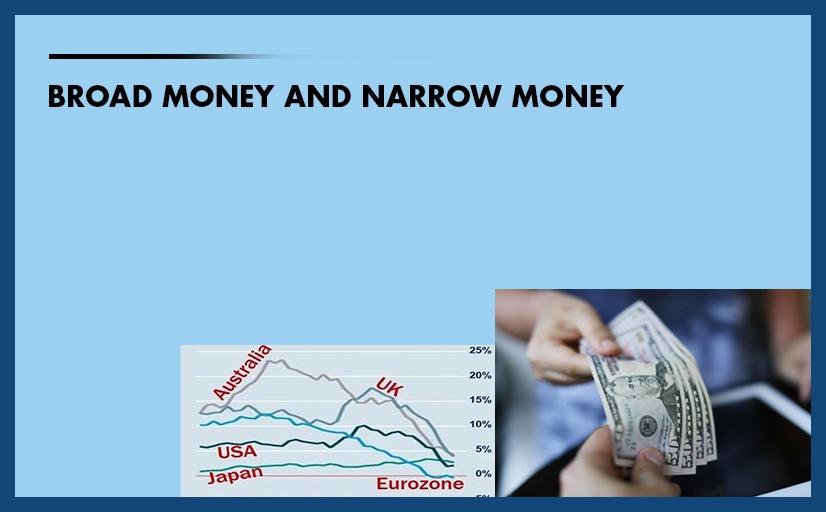
Broad Money and Narrow Money
Although the definitions of money differ from nation to nation, they typically include at least one measure for broad money and one for narrow money.
Broad Money and Narrow Money

Although the definitions of money differ from nation to nation, they typically include at least one measure for broad money and one for narrow money. Money is a means using which people exchange goods and services.
As inflation rises, the value of the Currency decreases. To track the money supply, the RBI divides it into three categories: reserve money, narrow money, and broad money. The most popular form of exchange is money. These types of money include bills, coins, and deposits into bank accounts. Since no citizen of the nation is permitted to refuse to accept them for payment, they are also known as legal tender. The balance of the money supply in the economy is, therefore, essential. Deflation is the term used to describe when prices in the economy start to decline as the money supply decreases. Nevertheless, inflation increases as the money supply increases and more money is printed.
Prior to examining the money supply in India or anywhere else in the world, two considerations must be made:
- Currency held by the Public
- Demand deposits held by the Public
Similarly to money demands, the money supply is a stock variable. The total amount of money in circulation among the general population at any given time is referred to as the "money supply." The four money supply measurements the RBI has made public are M1, M2, M3, and M4.
Their definitions are as follows:
Narrow Money (M1):
Extremely liquid or instantly withdrawable deposits are categorized as part of the money supply under the narrow money concept. In addition to currencies, other forms of payment are also accepted, such as demand deposits with quick withdrawal options or check facilities. It has referred to as narrow money. The Public's assets currently consist of the following assets that are the most liquid:
- Coins and banknotes in circulation make up the currency component.
- Demand Deposit Component: The Public's funds held by banks under the terms of demand deposits are available for withdrawal through ATM and check withdrawals.
In this context, demand deposit and currency components, which make up the country's money supply, are referred to as narrow money (M1). Thus,
M1
- M1 = Currency in circulation + Banking System Demand + Other Deposits with the RBI
M2
- Post offices, like conventional banks, provide time-saving, recurring, and time-deposit accounts. Only post office savings (= 'DEMAND deposits' type) are counted here.
- M2 = M1+ Post office bank savings
Broad Money (M3):
A wider variety of bank deposits and less liquid assets are called "broad money." Time deposits are restricted from being withdrawn before their predetermined maturity date. The time depots are added to the narrow money to create the wide money. This is what M3 stands for.
In this case, a new element known as a "Time Deposit" is added to Broad money. This component has a set maturity period and cannot be withdrawn before that period has passed. Narrow money (M1) is multiplied by time deposits to produce wide money (M3), which is calculated as follows:
M3 means:
M3 = Currency with the Public = Public Demand Deposits in Banks + Public Time Deposits in Banks
- M3 = M1 + Public Time Deposits with Banks
All public time deposits held by all banks, including cooperative banks, are included in the broad money.
The components of M3 are as follows.
- Residents' Term Deposits with the Banking System have a contractual maturity of up to and including one year
- Deposits with the Reserve Bank of India (RBI) are categorized as 'Other.'
- Residents' Term Deposits with the Banking System with a contractual term of more than one year
- The Banking System borrows from 'Non-depository' financial firms on a call/term basis
- The Public's Currency
- Deposits in the Banking System (SAVINGS)
- Bank-issued Certificates of Deposit
M4 means:
When a fourth component, Post Office Saving Deposits, is added to the M3, it becomes M4.
M4 = Currency in circulation + Public Demand Deposits in Banks + Public Time Deposits in Banks + Post Office Savings.
- M4 = M3 + Savings at the Post Office.
The terms "DD" and "CU" stand for cash (notes and coins) owned by the General Public, and "DD" stands for net demand deposits held by commercial banks. The phrase "net" refers to the money supply's inclusion of only publicly held bank deposits. Interbank deposits held by a commercial bank in other commercial banks are not included in the money supply.
M1 and M2 exemplify narrow money. M3 and M4 are two types of broad money. In decreasing order of fluidity, the gradations are displayed. While M4 has the least liquidity, M1 has the most and easiest to work with. M3 is the most popular measure of the money supply. It also goes by the name of total financial resources.
